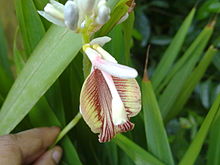Black cardamom
| Black cardamom | ||||||||||||
|---|---|---|---|---|---|---|---|---|---|---|---|---|

Black cardamom ( Amomum subulatum ) |
||||||||||||
| Systematics | ||||||||||||
|
||||||||||||
| Scientific name | ||||||||||||
| Amomum subulatum | ||||||||||||
| Roxb . |
The black cardamom ( Amomum subulatum ), also called Nepal cardamom or brown cardamom , is a species of the ginger family (Zingiberaceae). Its seeds are used as a spice , but other types of Amomum are also known as black cardamom.
Black cardamom comes from the eastern Himalayas and China and is mainly grown in Nepal and the Indian state of Sikkim .
description
Vegetative characteristics
Amomum subulatum grows as a perennial herbaceous plant and reaches heights of 1 to 2 meters. The leaf-bearing stem axes and the inflorescences arise directly from the branched rhizome . The pointed, glabrous, oblong-lanceolate , at the base rounded or wedge-shaped leaf blades are 25–60 cm long and 3.5–11 cm wide. While the lower leaves are almost sessile, the upper have a 1–3 cm long petiole.
Generative characteristics
The flowering period extends from May to June. The inflorescence shaft is 0.5 to 5 cm long and is covered with brown lower leaves . It bears the thickened, up to 5 cm diameter, approximately top-shaped inflorescence axis. The bracts are bright red, they have a characteristically hardened, blunt end. The bracts are tubular and about 3 cm long.
The hermaphrodite flowers are zygomorphic and threefold with double perianth . The calyx is fused up to half of its length. The crown is yellowish and about as long as the calyx.
The roundish, reddish to reddish-brown capsule fruits when ripe and 2 to 2.5 cm in diameter ripen in China in June to September.
The number of chromosomes is 2 n = 48.
Occurrence
Amomum subulatum is native to Southeast Asia and occurs on the southeastern edge of the Himalayas in Bhutan , Nepal and northern India, and further to the southeast in Bangladesh , Myanmar and southern China. The black cardamom grows in China at altitudes of 300 to 1300 meters.
use
The capsule fruits are used as a spice in a similar way to the green cardamom capsules , but the taste is different. In contrast to green cardamom, black cardamom is rarely used in desserts. It owes its tart, earthy aroma, reminiscent of coniferous wood and camphor , and its smoky taste to traditional drying over an open fire. The spice is mostly used in hearty meat dishes. It is also part of Indian cuisine .
Common names
Trivial names in other languages are: Chinese 草 果 , Pinyin Cǎo guǒ ; Vietnamese thảo quả .
swell
literature
- Delin Wu, Kai Larsen: Zingiberaceae. : Amomum subulatum Roxburgh , p. 355 - online with the same text as the printed work , In: Wu Zheng-yi, Peter H. Raven (Ed.): Flora of China. Volume 24: Flagellariaceae through Marantaceae , Science Press and Missouri Botanical Garden Press, Beijing and St. Louis, 2000, ISBN 0-915279-83-5 .
- Buroh, Nicolai, Gödert, Dorothee: The great book of herbs & spices. Gräfe and Unzer Verlag , 2008, p. 91.
- Seidemann, Johannes: World Spice Plants: Economic Usage, Botany, Taxonomy. Springer Verlag , 2005, p. 12.
Individual evidence
- ↑ a b c Delin Wu, Kai Larsen: Zingiberaceae. : Amomum subulatum Roxburgh , p. 355 - online with the same text as the printed work , In: Wu Zheng-yi, Peter H. Raven (Ed.): Flora of China. Volume 24: Flagellariaceae through Marantaceae , Science Press and Missouri Botanical Garden Press, Beijing and St. Louis, 2000, ISBN 0-915279-83-5 .
- ↑ Data sheet on Gernot Katzer's spice pages . Retrieved August 15, 2010


